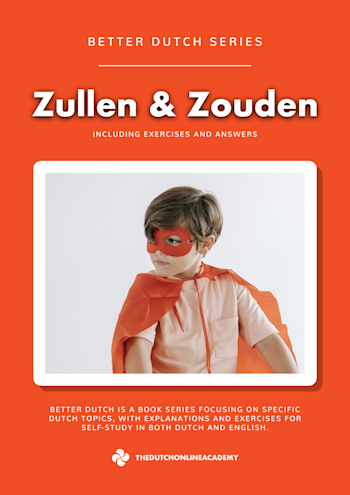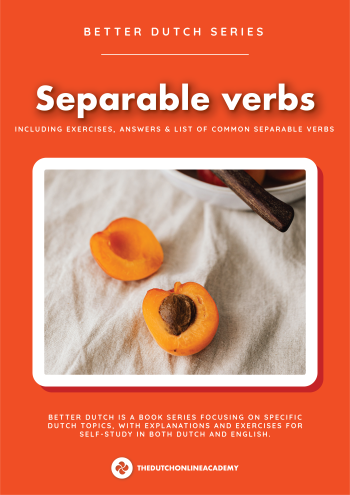Learn the theory
What are the Perfect and Imperfect tenses?
In Dutch you have different ways to talk about the past. You can use the perfect tense or the imperfect tense. Let's see what they look like.
Het Perfectum (Perfect tense):
Ik heb op dinsdag gewerkt.
Het Imperfectum (Imperfect tense):
Ik werkte op dinsdag.
Now the big question is: when do you use which? Let's start with some good news:
There are differences between the perfectum and the imperfectum, but in practice you can often use both. Dutch is very flexible in this, much more flexible than many other languages.
The use of the imperfect instead of the perfect or vice versa, does not impede communication. Yet your Dutch sounds more natural if you follow the rules.
What exactly is the difference?
The most important difference is:
You use the perfectum to name a single action in the past.
You use the imperfect to describe the past.
We look at an example:
Sentence 1. (Perfectum):
Ik heb gisteren een kaartje voor het concert gekocht.
Sentence 2. (Imperfectum):
Ik kocht gisteren een kaartje voor het concert.
In sentence 1. The focus is on the action or the result of that action. You bought a ticket and that's it.
In sentence 2. The sentence seems to describe the situation in the past. We expect a story to come.
Let's dive into sentence 2, in imperfect tense (imperfectum)
Ik kocht gisteren een kaartje voor het concert en vijf minuten later was het concert uitverkocht!
Ik was net op tijd.
Wat een geluk!
As you can see we are telling a story, where the imperfect is used for an action that is not the central point, but part of the whole.
Stories, such as fairy tales, are almost always written in the imperfectum. The same applies to descriptions of a period in the past.
You also almost always use the imperfect for emotions or character traits of people in the past.
Here are some examples.
- Roodkapje was onderweg naar haar grootmoeder, toen zij de wolf zag*.
- Vroeger schreven mensen brieven, nu gebruiken ze e-mail.
- Mijn opa was een hele lieve, intelligente man.
- Het feestje was fantastisch.
- Peter werd boos toen hij het nieuws hoorde.
*Listen to our podcast if you want to hear the story of Roodkapje (Red Riding Hood) in imperfectum.
Other differences between perfectum and imperfectum.
If the focus is on the result of an action or if the result is still perceptible, use the perfectum.
- Kijk, het heeft geregend. De straten zijn nat.
- Sorry, ik kom te laat. Ik heb mijn bus gemist.
- Bastiaan heeft zijn been gebroken, dus hij kan niet voetballen.
- Ik ben mijn sleutels verloren, dus heb ik een probleem!
If something has only happened once, never or a few times, you usually use the perfectum.
- Ik werkte vroeger in een café.
- Ik heb één dag in een café gewerkt.
- Ik heb een paar keer in een café gewerkt.
- Ik heb nooit in een café gewerkt.
These are the main differences you need to know to have a clear overview of the two tenses.
So, a small compilation, before we go to do the exercises.
What are the differences between Perfectum and Imperfectum in Dutch.
We use the Perfect tense:
To name a single action in the past.
When the focus is on the result of an action or if the result is still perceptible.
Something has only happened once, never or a few times.
We use Imperfect Tense:
To describe the past, in stories, fairytales or emotions and character traits of people in the past.
Practice with exercises
Pick the right option. Do you need perfectum or imperfectum?
Some ideas to keep learning
Once you know when to use the perfectum in Dutch, you still have some grammar to take into account. That's why we created the full guide about the Perfectum in Dutch. With examples, exercises, audio, videos and much more! (and it's free) and the full guide about Imperfectum in Dutch
What do you think about the perfectum and imperfectum in Dutch? Are you also struggling with the differences between the perfect and the imperfect tense? Let us know, we would be happy to help you out!
comments
Login to leave a comment



![Learn Dutch with The double infinitive in Dutch [list of auxiliary verbs included]](https://images.ctfassets.net/f8l4gy5qxe00/7fpaN2iBE3h1xS7LRL8c0h/3bbebedc080cbf7eece73424c8e3918f/The_double_infinitive.png?w=350&h=495&q=50&fm=png)